
I. Introduction:
Among the many contenders in the search for renewable and sustainable energy sources is biomass energy. Looking for other energy sources becomes more vital as the world struggles with the consequences of climate change and the depletion of fossil resources. Explored in this article is biomass energy, the green fuel of the future, and its potential to completely transform the energy industry.
Definition of biomass
Biomass, a renewable energy source formed from organic materials, is expected to be crucial to the worldwide shift to sustainable energy.
importance of sustainable energy sources
The need for switching to clean, green fuels has never been greater as the globe struggles with the urgent need to lower greenhouse gas emissions and slow down climate change. A viable substitute for conventional fossil fuels, biomass is renewable and adaptable.
Transition to green fuels
By using organic resources like wood, agricultural, and municipal solid waste, biomass energy generation is changing the energy landscape by lowering dependence on non-renewable fossil fuels.
It is evident as we explore the possibilities of biomass that this renewable energy source is the key to a more sustainable and environmentally friendly future.
The article attempts to give a comprehensive examination of biomass as the green fuel of the future, emphasizing its advantages, difficulties, and promising future possibilities.
II. Basic Advantages of Biomass
Environmental benefits
Energy from biomass is renewable, hence, it doesn’t contribute to the depletion of finite fossil fuels or the rise in greenhouse gas emissions. By absorbing and using carbon dioxide that would otherwise be released into the atmosphere, biomass energy production can in fact contribute to lower greenhouse gas emissions.
The production of biomass energy also advances carbon neutrality. Burning biomass for energy releases the same amount of carbon dioxide that the plants capture while growing. This makes the production of biomass energy an essential element of the worldwide attempt to slow down climate change.
Economic benefits
Energy security and independence
Ultimately, by offering a steady and dependable supply of energy, biomass energy generation promotes energy security and independence.
The production of biomass energy is a practical substitute for conventional energy sources since it can be included in the present energy infrastructure. Because biomass energy production can be regulated and managed locally, this lowers dependence on foreign oil and improves energy security.
All things considered, biomass energy generation offers a sustainable, economical, and ecologically acceptable substitute for conventional fossil fuels in order to meet our energy demands.
III. Disadvantages of Biomass Energy
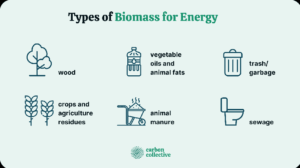
This covers black liquor from pulp and paper mills as well as firewood, wood pellets, wood chips, and sawdust from the lumber and furniture industries. Today’s biggest biomass energy source is wood.
Agricultural crops and residues:
Examples are algae, switchgrass, sugarcane, corn, soybeans, woody plants, crop residues, and food processing leftovers. Most of these are put to use in making biofuels.
Municipal solid waste (MSW): This includes biogenic materials such as paper products, cotton and wool products, and food, yard, and wood wastes.
Animal manure and human sewage:
These are used to generate biogas (sometimes referred to as biomethane or renewable natural gas) in anaerobic digesters at sewage treatment facilities as well as in dairy and animal businesses.
Short-rotation coppices and short-rotation forests:
These are regarded as sustainable since they are gathered immediately and, by 2050, could produce at least 25 EJ of energy per year.
The particular application—heat or power production, transportation fuels, or bioproducts—determines the feedstock type. The source and production techniques of bioenergy affect its climate effect differently.
V. Biomass Conversion Technologies
Thermochemical Conversion
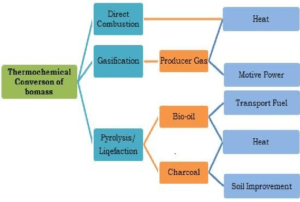
Thermochemical conversion is the process of converting biomass into energy and other useful byproducts by using heat and chemicals. This highly effective method can handle a wide variety of biomass feedstocks. The main techniques for thermochemical conversion consist of:
Combustion
The simplest and most often employed thermochemical process is combustion. It’s heating biomass by burning it with oxygen present. This heat can be utilized for heating or to power steam turbines to produce electricity. The combustion systems of today are made to reduce emissions and optimize energy efficiency. Those comprise:
- Direct Combustion: Biomass is burned directly to produce heat, which can be used in industrial processes, district heating, or electricity generation.
- Co-firing: Biomass is burned along with fossil fuels in power plants, reducing the reliance on coal and decreasing overall emissions.
Gasification
Mostly composed of carbon monoxide, hydrogen, and carbon dioxide, syngas (synthetic gas) is a mixture of gases produced by the gasification of biomass. In a setting lacking oxygen, this reaction takes place at high temperatures (between 700 and 1000 °C). Produced syngas can be applied to:
- Electricity Generation: Syngas can power gas turbines or internal combustion engines to produce electricity.
- Fuel Production: Syngas can be further processed to produce liquid fuels such as methanol or synthetic diesel.
Pyrolysis
Usually occurring between 350 and 600 °C, pyrolysis is the thermal breakdown of biomass in the absence of oxygen. The three principal products of this process are biochar, syngas, and bio-oil. Every good has specific uses:
- Bio-oil: a liquid that can be used as a fuel or processed into chemicals and materials.
- Syngas: Similar to gasification, syngas can be used for energy production.
- Biochar is a carbon-rich solid that can be used as a soil amendment to improve soil health and sequester carbon.
Thermochemical conversion processes are versatile and can be tailored to optimize the production of specific energy carriers or by-products, making them suitable for various biomass types and applications.
Biochemical Conversion
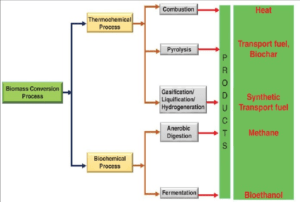
Biochemical conversion is the process by which biomass is broken down into simpler chemicals so that energy can be produced. Energy crops high in sugars, starches, or other biodegradable components and organic waste respond especially well to this technique. Primary biochemical conversion mechanisms include:
Anaerobic Digestion
Anaerobic digestion is the process by which bacteria break down organic material in the absence of oxygen. This procedure yields two primary results and takes place in regulated settings known as anaerobic digesters:
- Biogas is a mixture of methane (CH4) and carbon dioxide (CO2), which can be used for heating, electricity generation, or as a vehicle fuel after purification.
- Digestate is a nutrient-rich slurry that can be used as a fertilizer or soil conditioner.
Anaerobic digestion is widely used for treating organic waste from agricultural, industrial, and municipal sources. It helps in waste management while generating renewable energy.
Fermentation
Fermentation is the process of converting carbohydrates in biomass (such as sugars and starches) into alcohols or acids using microorganisms. The most common application is the production of bioethanol:
- Bioethanol Production:
-
Enzymatic Hydrolysis
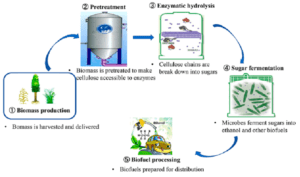
In enzyme hydrolysis, complex carbohydrates in biomass are broken down into simpler sugars. Bioethanol and other bio-based products can then be produced by fermenting these sugars. Fermentable sugars from lignocellulosic biomass (like wood, grasses, and agricultural wastes) are particularly dependent on this process.
Acid Hydrolysis
Acid hydrolysis breaks down biomass into smaller molecules by application of acids. As effective as it is, it can be less ecologically friendly and more corrosive than enzymatic hydrolysis.
Using biochemical conversion procedures is essential to turning biomass into biofuels and bioproducts. Their sustainable substitutes for chemicals and fuels derived from fossil fuels support a circular bioeconomy.
VI. Challenges and Solutions
By increasing efficiency and cutting emissions, technological developments can help solve these problems. Practices for sustainable agriculture can lessen these problems.
VII. Applications of Biomass
Application areas for biomass energy are many and include industrial operations, transportation fuels, heating and cooling systems, and power generation.
Power Generation
By means of direct combustion, co-firing with other fuels, gasification, and anaerobic digestion, biomass energy is used to produce electricity. Burning biomass directly results in steam that powers turbines to produce electricity.
Using biomass in conjunction with other fuels to generate power is known as co-firing. Gasification converts biomass into a synthesis gas (syngas) that can be used to produce energy. Biogas is produced during anaerobic digestion of biomass in the absence of oxygen and is used to produce power.
Heating and Cooling Systems
Industries, businesses, and homes all use biomass energy for heating and cooling systems. Cooking and heating of spaces are done with biomass in homes. Commercial buildings are heated, and hot water is produced with biomass. Industrial environments employ biomass for power and steam generation.
Transportation Fuels (Biofuels)
Biofuels, including ethanol and biodiesel, are produced from biomass energy. Biodiesel is made from vegetable and animal fats; ethanol is made from crops like corn and sugarcane. To cut greenhouse gas emissions, biofuels may be mixed with fossil fuels or used in place of them directly in cars.
Industrial Processes
In many industries, including food processing, textile mills, and pulp and paper mills, biomass energy is used to generate steam, electricity, and heat. In addition to reducing greenhouse gas emissions, it also produces bioproducts, including bioplastics and biodegradable packaging materials.
VIII. Case Studies
Successful Biomass Energy Projects Around the World
Biomass energy projects have been successfully implemented across the globe, showcasing the potential of this renewable energy source to provide sustainable energy solutions. These projects demonstrate the versatility of biomass energy and its ability to meet diverse energy needs.
Case Study 1: Ethanol from Sugarcane in Brazil and Zimbabwe
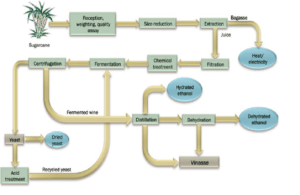
In Brazil, sugarcane is a significant source of ethanol, which is used as a biofuel. This project highlights the potential of biomass energy to reduce greenhouse gas emissions and promote energy security. Similarly, in Zimbabwe, sugarcane is used to produce ethanol, which is used as a transportation fuel. This project showcases the potential of biomass energy to improve energy access and reduce dependence on fossil fuels.
Case Study 2: Community Biogas in an Indian Village

In an Indian village, a community-driven biogas project was implemented to produce biogas from agricultural waste. This project demonstrates the potential of biomass energy to improve energy access and reduce waste disposal issues. The biogas produced is used for cooking and lighting, providing a sustainable energy solution for the local community.
Case Study 3: Land Rehabilitation for Fuel and Fodder in India

In India, a land rehabilitation project was implemented to produce fuel and fodder from agricultural waste. This project highlights the potential of biomass energy to promote sustainable agriculture practices and reduce waste disposal issues. The fuel and fodder produced are used for local energy needs, reducing dependence on fossil fuels.
Case Study 4: Biomass Power Plant in the United States

In the United States, a biomass power plant was implemented to generate electricity from wood waste. This project demonstrates the potential of biomass energy to reduce greenhouse gas emissions and promote energy security. The plant uses wood waste from local sawmills and forests, reducing waste disposal issues and promoting sustainable forestry practices.
Case Study 5: Biomass Heating System in Finland

In Finland, a biomass heating system was implemented to provide heat to a local community. This project highlights the potential of biomass energy to promote energy independence and reduce greenhouse gas emissions. The system uses wood chips as the primary fuel source, reducing dependence on fossil fuels and promoting sustainable forestry practices.
IX. The Future of Biomass: Innovations and Challenges
The possibilities for biomass as a sustainable fuel are endless, but there are certain obstacles to overcome. Future directions for energy efficiency and production are promised by the continuous research and development in biomass technologies. Advances in genetic engineering are enabling high-yield energy crops and more efficient biofuel production methods.
The development of advanced biofuels like cellulose, ethanol, and algae-based fuels represents the next step in biomass energy.With their potential to greatly cut greenhouse gas emissions, these cutting-edge biofuels offer a long-term substitute for traditional fuels. But getting beyond technical and financial obstacles will determine their commercial success.
But resolving a number of obstacles will be necessary before biomass energy is widely used. These comprise technical difficulties with the effective conversion of biomass, financial obstacles like the expensive initial costs of bioenergy infrastructure, and practical difficulties with the gathering, moving, and storing of biomass feedstock.
To be sure that the production and use of biomass do not result in deforestation, biodiversity loss, or unfavourable social effects, its sustainability must also be carefully evaluated. To overcome these obstacles and fully exploit biomass, governments, industry stakeholders, and communities must work together.
X. Conclusion: Embracing the Green Fuel of Tomorrow
A bridge to a future of sustainable energy is biomass. It provides a flexible and renewable energy source and is evidence of both human creativity and the inventiveness of nature. Accepting biomass will help us to lower our carbon footprint, improve energy security, and promote economic expansion. As we negotiate the challenges of the twenty-first century, let us turn to biomass as a sign of our dedication to a more sustainable and environmentally friendly world as well as a fuel.
Finally, biomass’s journey from an ancient energy source to the green fuel of the future is one of possibility, sustainability, and innovation. This narrative captures the effort of all of us to balance the needs of a contemporary world with nature.
FAQs
1. What are the environmental benefits of using agricultural residues for energy?
Agricultural residues can improve soil quality by reducing water loss through evaporation and enhancing soil fertility. They also provide a sustainable source of energy, reducing greenhouse gas emissions and dependence on fossil fuels.
2. How does the production of bioethanol from sugarcane impact the environment?
Bioethanol production from sugarcane can have both positive and negative environmental impacts. On the positive side, it can reduce greenhouse gas emissions and provide a sustainable energy source. However, it can also lead to land use changes, water pollution, and increased energy consumption during production.
3. What are the economic benefits of using biomass for energy production?
Biomass energy production can create jobs and stimulate local economies, particularly in rural areas. It can also reduce energy costs and increase energy security by providing a domestic energy source
4. How does biomass contribute to reducing greenhouse gas emissions?
Biomass energy production can reduce greenhouse gas emissions by replacing fossil fuels and providing a renewable energy source. It can also sequester carbon dioxide during biomass growth, making it a carbon-neutral energy source.
5. What are the main differences between combustion, gasification, and pyrolysis in biomass conversion?
Combustion involves burning biomass to produce heat or electricity. Gasification converts biomass into a synthesis gas (syngas) that can be used for power generation or as a transportation fuel. Pyrolysis involves heating biomass in the absence of oxygen to produce bio-oil, which can be used as a transportation fuel or for industrial processes.
6. How does biomass compare to other renewable energy sources in terms of efficiency?





Hello
I wish to have a private business discussion with you that involves millions and this would be of a great benefit to both parties if handled well.
Kindly get back to me with your phone number for more details.
Thanks,
Williams Delar
Wdelar@w-private.com
[…] why solar energy is regarded as a renewable energy source before learning how it is transformed into […]
[…] including employing sustainable materials, running a green cleaning program, switching to renewable energy sources, and giving enough […]
[…] Pyrolysis, on the other hand, thermally decomposes biomass to produce bio-oil, syngas, and char. Bio-oil can be refined into transportation fuels, while syngas can be used similarly as in gasification, and char can be utilized as a soil conditioner or activated carbon. These advanced technologies enhance the versatility and efficiency of biomass as a renewable energy resource. […]
[…] and scientists can optimize hydroelectric power generation to derive the maximum amount of renewable energy while minimizing environmental impact and improving overall […]
Your point of view caught my eye and was very interesting. Thanks. I have a question for you.